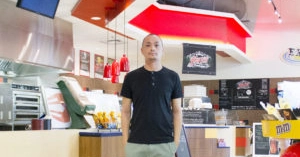Nestled in the heart of MacEwan University’s Robbins building, you can find Asian cuisine that tastes just like a home-cooked meal (or better). Since 2008, Filistix has been providing Edmontonians with Filipino-inspired dishes from three different indoor locations and a food truck. Cousins Ariel del Rosario and Roel Canafranca, the owners of Filistix, are often credited for being one of the first businesses to start a street food culture in Edmonton. Ariel sat down with the griff to discuss his passion and commitment for creating quality food, as well as his experience of being a pioneer of street food culture in Edmonton.
Why did you and your business partner want to create Filistix in the first place?
A: Roel’s not only my business partner, but he’s also my cousin, so we’ve grown up together. We’ve always been in the food industry, so we’ve always been into food. The path that I took was a more corporate path. I did Asia Pacific management here at MacEwan, and then I did my bachelor of commerce at the U of A, and then I did my masters at the University of Liverpool. [Roel] did his psychology degree at Concordia, so we were both doing our own thing. In 2008, I had been working for a German company, so I’d been doing a lot of travelling and I noticed that pretty much anywhere else except in North America, there was a street food culture. So we were thinking, “There’s nothing like that here, so why don’t we try and develop a street food culture in Edmonton?” — which was kind of a grandiose idea. It was super ambitious, but we weren’t thinking we’d develop it entirely. We just wanted to do something like that.
How did you go about getting that started?
In 2008, we invested in a food trailer, which was this nondescript, square box that kind of looks like an electrical box. The first year, we didn’t have any decals, so people didn’t really even know that we were selling food out of it. There was a window and we had a menu and people were like, “What the hell?” We set up on Rice Howard Way, and there was a Fat Franks vendor there. Roel did some market research, and he sat out there for about a week and he watched how many customers went through the Fat Franks vendor. There were like 200-300 in a day. We were like, “We could do that! Let’s do that!” We didn’t realize that people weren’t really open to buying food out of this nondescript trailer, because there was no such thing as street food, there was no such thing as food trucks or anything like that. There was Fat Franks. So, we were basically creating a market when a market wasn’t there. So we were thinking, “Oh man, if he’s selling 200 to 300 hot dogs, we could do at least 100 [sales].” In our first summer, on average, we had eight sales a day. We were struggling, and we did that for two seasons. Roel did it full time, and I continued on with my job just so that we could pay for our product. Year three, we were like, “You know what? It’s either we pack it up, we forget about it — we tried it, all good — or we just refocus and re-strategize and just do stuff like festivals and farmers’ markets — things that we know that we could have some sort of market to sell to but not commit ourselves everyday, and struggle every day to make 10 sales.” So we got into City Market on 104th [Street], we did a bunch of local festivals, and just did some one-offs just to keep the brand going and get our brand out there.
Were there any particular events that really helped you make the Filistix name more popular?
In 2011, there was a food truck festival called What the Truck. We did the very first What the Truck, and there were six of us. It was really well-marketed and really well-advertised, so there were a few hundred people there. It turned out that we had the longest line out of any of the trucks, and it just so happened that out of the blue, Aramark (which has the food services rights to MacEwan and the U of A) sent some representatives down just to see what was going on. The director of operations at the time approached us, and said, “Hey, would you guys be interested in setting up on the U of A campus?” And we were like “Psshh, yeah!” When we did our business plan, that was what we wanted to do, was to get into the universities. It was a stroke of luck that they approached us, instead of us trying to figure out how to get into the U of A.
How did you get into MacEwan?
Kris Bruckmann [current director of Retail and Hospitality Operations at MacEwan] used to work for Aramark, so he used to run Aramark at MacEwan. He gave me a call and was like, “Hey, I hear you guys are doing good things at the U of A. Would you guys be interested in talking about expanding out into MacEwan?” So we sat down in early December 2011, and I think it was mid-January that we were open at the Robbins.
Why did you want to get into the universities in the first place?
There are 18,000 students here every day. You know that there’s going to be people here every day. So, I mean, the market was ripe.
Plus, when I was going to university, there were no decent food options. There was fast food or heavily processed food. No vendor was really advocating for purchasing local, or making their food from really sustainable products. When we first opened, we were all about that. We were all about going organic, local, that kind of stuff. But honestly, from a business perspective, it doesn’t make sense to do that. For one thing, it’s cost prohibitive. We do a lot of volume, and our suppliers would never be able to keep up with our volume, so it just doesn’t make sense. We’ve kind of rejigged our strategy, and we try to be local and sustainable where it makes sense. It’s not completely in Edmonton, like 50 km around, but it is Canadian. All of our to-go bowls and our cutlery are compostable and biodegradable — we’re all about that.
And the food itself is Filipino-inspired, correct?
The name Filistix is actually a contraction. “Fili” is “Filipino” and in the Philippines, we have barbecue sticks that are like pork skewers. We put “Fili” and “barbeque sticks” together as Filistix. When we first opened, that was our main menu item — these pork skewers. We’re really for doing Filipino food, just because we are Filipino. That’s our background and that’s the food that we know, but we morphed our menu into more of an Asian-inspired menu. Our two main menu items, the classic chicken adobo and the South Pacific coconut chicken, are Filipino items, but we do anything from Japanese to Indian to Thai. Another thing that we’re really proponents of are vegetarian dishes, because there aren’t very good choices on campus for vegetarian food.
Are you and Roel chefs?
No, not trained.
But you do cook everything?
Oh, yeah!
So you are chefs!
Well, not trained, but we are “chefs.” We’ve developed the menus all by ourselves. We’ve developed everything: all our dressings, all our sauces. Since I was 14, I was bussing tables at restaurants. At 16, I was working at Earls. We worked in the kitchen, so we know how to cook — we’re cooks, not chefs.
What’s the difference?
To me, it’s if you have that paper, that red seal.
I’m not a chef. I’m just a guy who likes to cook.
Have you found that students have responded well to the food that you make?
Yeah, absolutely. It’s been crazy because this is the newest building on campus, but it’s also the least populated building on campus, so it’s been a little bit of a struggle trying to get the name out there. But whoever has classes in this building comes here for lunch. We know their faces. They’re regulars. We get a ton of staff from the other buildings. It’s still kind of tough getting students that have classes in Building 5 to make that four-block walk over here, but it’s worth it to walk over here to get some decent food, as opposed to going to Subway or Pizza 73.
What are your thoughts on the whole local-vendor-versus-chain-food-supplier debate?
When Aramark brought us in as a food truck, they also invited about four other food trucks at that time. It was a pilot project, and their director of operations was really gung-ho and was like, “We’re going to revolutionize campus food!” Then, of course, somebody from higher up in head office squashed that and was like, “We’re going to bring in more international brands because this is tried and true. This is what’s going to augment our quality.” But really, that’s so far from what their customers want. Their customers want great-tasting food, number one. Number two: something that’s healthy. Number three: a great price point. I’ll admit that our price point is not the cheapest, but for the quality you get and the value that you get, you know — that’s why we’re so busy.
This interview has been edited for length and clarity.
Photo by Madison Kerr





0 Comments